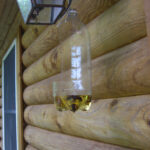The Blue Angels, the U.S. Navy’s renowned flight demonstration squadron, are a spectacle of precision, skill, and breathtaking maneuvers. When witnessing their airshows, a common question arises: How Fast Do The Blue Angels Fly? The answer isn’t a single number, as their speed varies dramatically depending on the maneuver and aircraft, but understanding their velocity is key to appreciating the incredible feats of these elite pilots.
Unveiling the Speed of the Blue Angels in Airshows
The Blue Angels’ performances are a dynamic showcase of naval aviation prowess, and speed is a crucial element of their demonstrations. While not always flying at their maximum speed, they utilize velocity to create dramatic and awe-inspiring displays.
One of their most talked-about maneuvers, the Sneak Pass, provides a direct answer to “how fast do the Blue Angels fly?”. During this high-speed maneuver, a Blue Angel jet streaks past the audience at approximately 700 miles per hour (mph). This speed is just shy of Mach 1, the speed of sound, creating a thrilling visual and auditory experience for spectators.
Beyond the Sneak Pass, other maneuvers also involve significant speeds. While specific speeds for every maneuver are not always publicly disclosed, it’s understood that elements like formation flying, loops, and rolls are performed at varying, yet consistently high, speeds to maintain momentum and aerodynamic control. The Opposing Knife-Edge Pass, for example, involves two jets approaching each other rapidly before executing sharp turns, demanding precise speed management.
Factors Influencing the Blue Angels’ Flight Speed
Several factors dictate how fast the Blue Angels fly during their performances:
- Maneuver Type: Different maneuvers require different speeds. High-speed passes like the Sneak Pass are designed for maximum velocity, while formation flying and tighter turns necessitate slower, more controlled speeds.
- Aircraft Capabilities: The current aircraft, the F/A-18 Super Hornet, is a high-performance fighter jet capable of exceeding Mach 1. However, airshow performances are conducted within safe and visually optimal speed ranges. Historically, the Blue Angels have flown various aircraft, each with different speed capabilities.
- Safety and Precision: While speed is thrilling, safety and precision are paramount. The Blue Angels fly in extremely close formations, sometimes just 18 inches apart. Maintaining these formations requires meticulous speed control and adjustments.
- Environmental Conditions: Weather conditions such as wind speed and direction can also influence flight speeds and maneuver execution.
From Propeller Planes to Supersonic Jets: The Evolution of Speed
The Blue Angels’ history reflects the evolution of aviation technology and speed capabilities. Initially flying Grumman F6F Hellcats, propeller-driven aircraft from the World War II era, their speed was considerably lower than today’s jets.
Over the decades, the squadron transitioned to increasingly advanced jet aircraft, including the F9F Panther, F-11 Tiger, F-4J Phantom II, and the F/A-18 Hornet before adopting the F/A-18 Super Hornet in 2021. This progression mirrored the advancements in jet engine technology, allowing for significantly higher speeds and more dynamic performance capabilities. The Super Hornet, with its supersonic capabilities, represents the pinnacle of speed and maneuverability in the Blue Angels’ aircraft history.
Why Speed is Essential to the Blue Angels’ Spectacle
Speed is not just about thrill; it’s integral to the Blue Angels’ mission and performance:
- Showcasing Naval Aviation Prowess: High speeds demonstrate the power and capabilities of naval aircraft and the exceptional skills of the pilots who operate them.
- Creating Dynamic Maneuvers: Speed provides the energy needed to execute complex aerobatic maneuvers, loops, rolls, and formations that defy gravity and captivate audiences.
- Highlighting Precision and Control: Managing high speeds in tight formations underscores the incredible precision and control the Blue Angels pilots possess. It emphasizes their rigorous training and expertise.
- Engaging Spectators: The sheer speed and sound of jets flying at 700 mph create an unforgettable sensory experience, inspiring awe and patriotism in viewers.
More Fascinating Facts About the Blue Angels
Beyond their impressive speed, the Blue Angels are steeped in history and unique characteristics:
- Ambassadors of Naval Aviation: Their mission extends beyond airshows. They serve as ambassadors, showcasing the teamwork and skill of the Navy and Marine Corps to millions annually.
- World War II Roots: Founded in 1946 by Admiral Chester Nimitz, the team was created to maintain public interest in naval aviation post-WWII.
- Elite Pilots with Stringent Requirements: Blue Angels pilots are drawn from the ranks of experienced Navy and Marine Corps tactical jet pilots, requiring thousands of flight hours and carrier qualifications.
- Named After a Nightclub: Their distinctive name was inspired by the “Blue Angel” nightclub in New York City.
- Non-Combat Role: While their jets are combat-capable, the Blue Angels squadron does not engage in combat missions. Their focus is on demonstration and recruitment.
- No G-Suits: Uniquely, Blue Angels pilots do not wear G-suits, relying on muscle control and breathing techniques to manage G-forces, as G-suits would interfere with flight controls.
Conclusion: The Thrill of Speed and Precision
So, how fast do the Blue Angels truly fly? While speeds vary depending on the maneuver, reaching up to 700 mph in demonstrations like the Sneak Pass, their velocity is always managed with incredible precision and skill. The Blue Angels are more than just fast jets; they represent the pinnacle of naval aviation expertise, captivating audiences with a blend of speed, artistry, and breathtaking maneuvers. Their performances are a testament to the dedication and rigorous training of these elite pilots, inspiring generations with the power and beauty of flight.
